| | Tech Tips - Business IT Support Tips
Posts Tagged ‘hard drives’
Wednesday, February 15th, 2012
There have been countless articles written to help you with reducing temporary files that clutter your hard drive. Windows performs cleanup for most of these files under normal circumstances, but control over the process is limited. To gain more control over these files, you can use CleanMgr as part of a normal monthly maintenance cycle.
In a modern Windows OS, when you click Start/Accessories/System Tools/Disk Cleanup you will note a dialog which will eventually present you with choices of files to remove from your computer. These are left over files from various activities and will look something like this:
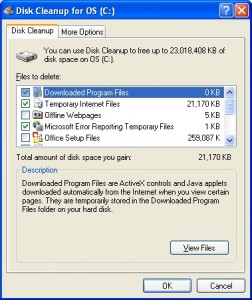 Disk Cleanup can assist you in removing no longer needed files Now you are able to select the categories you want to remove, for example, Temporary Internet Files, Microsoft Error Reporting Temporary Files, Recycle Bin, Temporary Files, WebClient/Publisher Temporary Files, etc. Note these are all temporary files. There are also other categories you should normally never select. These include Office Setup Files, Log Files, Compress Old Files and Catalog files for the Content Indexer. Please note Windows Vista and Windows 7 users will have more options available.
If this is the first time you have ran CleanMgr (Disk Cleanup), the initial scan process could take quite some time. These scan’s may take in excess of an hour. Microsoft had provided a way to streamline this process through preferences, but you have to use the Command Prompt to take advantage of it.
To get started we’ll need to use the CMD prompt. Alternatly, you can “Run” a command from the “Start Button” this will work too.
Let’s start with the CMD prompt:
For Windows XP click Start/Run/CMD
For Windows 7 click Start/All Programs/Accessories/Command Prompt
This will open a Command Console allowing you to type in the following command:
cleanmgr.exe /sageset:99
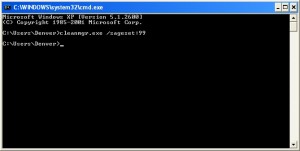
Running CleanMgr from the Command Prompt
This will bring up a new Disk Cleanup Settings window
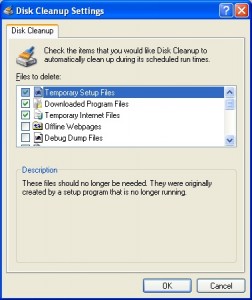
On Windows XP computers, you should usually select the following categories: Temporary Setup Files, Downloaded Program FIles, Temporary Internet Files, Microsoft Error Reporting Temporary Files, Old Chkdsk files, Recycle Bin, Temporary Remote Desktop files, Temporary Files, WebClient/Publisher Temporary Files, Catalog files for the Content Indexer. Optionally you could select Debug Dump Files and Offline Webpages as well. You should almost NEVER select Office Setup Files.
On Windows 7 computers, you should usually select the following categories: Temporary Setup Files, Downloaded Program Files, Temporary Internet Files, Debug Dump Files, Old Chkdsk files, Recycle Bin, Service Pack Backup Files, System error memory dump files, System error minidump files, Temporary Files, Temporary Windows installation files, Thumbnails, Files discarded by Windows upgrade, Per user archived Windows Error Reporting Files, System archived Windows Error Reporting Files
Once you have made your selections, Click OK.
Now that you have saved your settings, run the following command:
cleanmgr.exe /sagerun:99
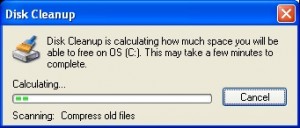 - The Sagerun Switch
This process could take some time to complete and will run on all attached drives. So if you have network drives or external drives you do not want included, be sure to disconnect or remove these drives.
For more information about using CleanMgr from the command line please reference:
http://support.microsoft.com/default.aspx?scid=kb;en-us;Q315246 (for Windows XP)
http://windows.microsoft.com/en-us/windows7/Delete-files-using-Disk-Cleanup (For Windows 7)
my PC Techs provides expert computer repair and computer consulting services to the Phoenix metro area. For more information or to schedule an appointment please call (602) 456-0150.
Tags: cleanmgr, cleanup, computers, disk cleanup, files, hard drives, temporary files, windows
Posted in Tech Club General | No Comments »
Saturday, December 3rd, 2011
When we repair a computer at my PC Techs, one of the first items on our list of work to perform is dust removal. In Arizona, dust is a big problem and coats everything. When a new computer comes into our shop we never really know just how much dust we are going to see! It’s always a surprise when you “pop the case” of a computer for the first time.
Here are a few pictures of the inside of a case that recently came into our workshop.
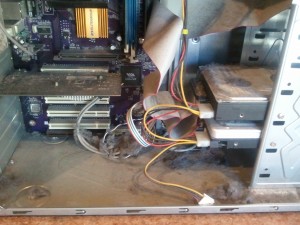 Over time, dust accumulates inside your computer case 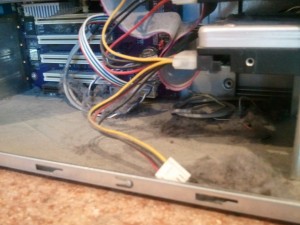 Over time, dust can cause internals components to overheat, due to lack of air circulation Dust is a slow computer killer. Dust prevents normal air circulation through the computer case. The case draws cooler air from outside the case through the various airflow openings of the case. The lack of circulation caused by dust will often result in internal component overheating and failure. These include video cards, hard drives, computer processor and other internal hardware.
Common intake openings of the case include the front and the sides of the case, while exit openings include fans usually mounted in the rear of the case and the power supply.
Keeping these openings clear of debris can help to maintain the proper airflow around the case. A good practice is to also maintain four to six inches of clearance from the computer to any object which could block airflow.
In conclusion, dusting out your case every month can help to extend the life of your computer – instead of it suffering the fate of death by dust.
Tags: air, case, circulation, computer, death, dust, dust removal, fans, hard drives, killer, overheating, Processor, video cards
Posted in Tech Club General | No Comments »
Sunday, September 19th, 2010
How does your office connect to the internet? Many small offices today utilize at least one form of traffic filtering, a router that sits between their internal network and their connection to the internet. The router employed is most likely a simple NAT device, allowing traffic out of the network while protecting the internal network from outside visibility and direct attempts to hack the computers and servers inside.
However, most routers in this category don’t do enough to protect the users in the office from virus attacks, spyware, or hackers. Malicious web pages and emails bypass basic protections offered by a router, and the majority of virus infected computers we have repaired were infected by one of these two methods. A user either used a browser to visit an innocent looking website that was infected, or they clicked on an email that contained a malicious file.
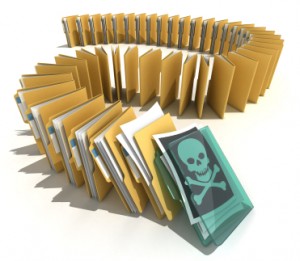 The negative effects shared by all when an office machine becomes infected include loss of work, slow computers, infection of servers and critical company files, and in worst case scenarios theft of company data. Consider the installation of additional security on your network to help guard against these types of attacks. An inexpensive server, often purchased and installed for less than $1,500, can be configured and placed between the internet and the internal network. This server, with the proper software installed and maintained, will filter out malicious emails and web pages and block them before they reach computers in your office. The negative effects shared by all when an office machine becomes infected include loss of work, slow computers, infection of servers and critical company files, and in worst case scenarios theft of company data. Consider the installation of additional security on your network to help guard against these types of attacks. An inexpensive server, often purchased and installed for less than $1,500, can be configured and placed between the internet and the internal network. This server, with the proper software installed and maintained, will filter out malicious emails and web pages and block them before they reach computers in your office.
The server can perform additional roles as well. From allowing VPN access, to remote desktop, centralization of files, and simplifying the management of all computers in the office. Consult with our expert team today to learn the many ways a server solution can benefit your office, including the protection of your network and company data. Call my PC Techs at (602) 456-0150 for a free consultation.
Tags: anti-virus, Arizona, bugs, computer, computer crashes, data leak, hard drives, machines, PC parts, phoenix, protecting, software, spam, technology, Updating
Posted in Tech Club General | No Comments »
Saturday, September 18th, 2010
 We do work for several restaurants and retail stores here in Phoenix, Arizona. These shops are all using windows based point of sale systems. While the software and database that run on the computers to transact credit card payments and process menu items are highly customized and supported by the franchise in most cases, the underlying operating system and hardware is not. We do work for several restaurants and retail stores here in Phoenix, Arizona. These shops are all using windows based point of sale systems. While the software and database that run on the computers to transact credit card payments and process menu items are highly customized and supported by the franchise in most cases, the underlying operating system and hardware is not.
We have learned a lot about these systems and can say with certainty that the biggest issues we have run into are lack of proper backups and lack of spare hardware. When a point of sale system goes down for a store, especially a busy store, it is NO FUN. Employees need to process payments manually by hand and write out paper receipts. As you can imagine, the slowdown at the register does a lot to aggravate customers and employees alike. But there are three things that you can do as a retail store business owner to minimize downtime in the event of a system crash.
1. Perform regular system maintenance
Hiring a firm like my PC Techs to regularly maintain your equipment each month can save you from several hours worth of headache and hundreds or thousands of dollars in lost sales. Our technicians will visit your store and examine your systems for irregular performance. System errors, faulty hardware, failing hard drives, botched OS updates, and corrupted data can, in many cases, be identified and corrected before it becomes a larger problem. Dust can be cleaned out (the largest cause of hardware failure), and parts inspected. Unnecessary programs can be removed and system performance improved. The best part of this scenario, the repairs can be performed before or after regular hours, so customers never experience delay.
2. Perform regular, complete data backups
Usually during the same time as the system maintenance, our technicians can perform a complete data backup of all of your POS systems. This is important. When a hard drive crashes, you want to get your system back online as quickly as possible. To rebuild an entire system, restore data from on off site repository, and get all the hardware and software working correctly could take many hours. With a complete system backup, it could be as simple as popping in the right piece of replacement hardware and running a 30 minute recovery.
3. Identify and build an inventory of replacement parts
When a system failure happens, recovery time can be improved considerably when the right spare parts are kept on hand. Rather than buying hard to find computer equipment online, and waiting for it to be shipped, a replacement part can be obtained from storage and quickly installed to replace the broken component. That part can later be replaced to storage, so you always have a backup on hand for the next time disaster strikes.
When you think about the security of your data and your ability to transact business, keep in mind your local computer experts and ways that they can work with you to help improve the reliability of your computer operations. For help with the maintenance and emergency support of your POS systems, contact my PC Techs today. (602) 456-0150.
Tags: Arizona, backup, backups, based, business, business owner, buying, cleaned, clients, computer, computer equipment, computer experts, computers, corrupted, credit card, customers, data, data backup, database, delay, disaster, dollars, downtime, dust, employees, equipment, errors, failure, faulty, franchise, goes down, hard drive, hard drives, hard to find, hardware, headache, hours, improve, improved, inspected, issues, maintain, maintenance, menu items, minimize, month, my pc techs, online, operating system, operations, OS, parts, payments, PC, performance, phoenix, point of sale, pos, problem, process, programs, projects, rebuild, receipts, recovery, register, reliability, removed, replacement, replacement part, restaurants, restore, retail, retail tores, sales, security, shipped, software, spare, storage, store, system, system crash, system maintenance, systems, technicians, transact, windows
Posted in Tech Club General | No Comments »
Wednesday, September 8th, 2010
Can anyone name a small business, or any business for that matter, that doesn’t rely upon technology for day to day operations? Computers play such an integrated role in our lives. Much like automobiles, it is important to maintain your computers and run periodic checks on them to avoid failure.
When doing routine system maintenance, there are several different areas of the computer that should be checked for potential problems. The operating system itself, installed software, updates and patches, anti-virus definitions, the network settings, the system fans, dust levels, hard disk drives, backups, and external devices! Some are more important than others. For example, if your hard drive fails, you could face some very costly data recovery issues. Dust is another one, dust and heat are the biggest killers of electronic components. A competent computer repair firm will have a checklist of items that a technician will run through, the hard drive and dust levels being just one of those, to ensure optimal performance.
Not to get stuck on the automobile analogy, but it’s so easy to do comparisons between that and computer repair. If you forget to change your oil, over time your engine suffers. If you go long enough, eventually your engine will fail. Computer maintenance is the same way. A lot of clients have come to us with failed hard drives. Sometimes we can get their data off pretty easily and recover their systems. In the worst cases, those hard drives need to be sent off to a lab where data recovery becomes extremely costly. Client with crashed hard drives are usually surprised when we tell them that the crash could have been avoided. There are warning signs that most equipment will give when things go bad, and the signs usually begin a while before the actual crash takes place. For hard drives, it could be slow performance, errors while working, errors in system logs, or even clicking or grinding sounds. Most computer fans make noises too when they are about to fail.
Our experts service and repair machines and are experienced in the different ways you can identify computer problems. If you hire a team of professionals that know how to keep your computers working, and have them come out monthly for a quick checkup, you too will be able to keep working. For most people, computer failures usually happen at the worst possible time. Like, right before an important project deadline. If your computer suddenly crashes or the network is not working you may lose work and income. All of this could be avoided with just a couple hours of preventative maintenance per month.
>> Did you like this article? Ping it!
Tags: anti-virus, automobiles, avoid, backups, business, checklist, checks, checkup, clicking, clients, components, computer, computer maintenance, computer problems, computer repair, computers, costly, crash, crashed, crashes, data, data recovery, deadline, drives, dust, electronic, engine, equipment, errors, experts, external devices, fail, failed, failure, failures, fans, firm, grinding, hard disk, hard drive, hard drives, heat, hire, items, killer, lab, lives, machines, maintain, monthly, network, operations, patches, performance, problems, professionals, project, recover, rely, repair, role, service, settings, slow performance, small business, software, system, system logs, system maintenance, systems, team, technician, technology, updates, warning signs, working
Posted in Tech Club General | No Comments »
WE WORK HARD FOR YOU, BUT DON'T JUST TAKE OUR WORD FOR IT!
We've helped over 1,000 satisfied businesses throughout the Phoenix valley, click here to view some of their testimonials:

©2010 my PC Techs is owned and operated by Leo Polus, L.L.C., concept by Andre Morris |
| |







 The negative effects shared by all when an office machine becomes infected include loss of work, slow computers, infection of servers and critical company files, and in worst case scenarios theft of company data. Consider the installation of additional security on your network to help guard against these types of attacks. An inexpensive server, often purchased and installed for less than $1,500, can be configured and placed between the internet and the internal network. This server, with the proper software installed and maintained, will filter out malicious emails and web pages and block them before they reach computers in your office.
The negative effects shared by all when an office machine becomes infected include loss of work, slow computers, infection of servers and critical company files, and in worst case scenarios theft of company data. Consider the installation of additional security on your network to help guard against these types of attacks. An inexpensive server, often purchased and installed for less than $1,500, can be configured and placed between the internet and the internal network. This server, with the proper software installed and maintained, will filter out malicious emails and web pages and block them before they reach computers in your office.  We do work for several restaurants and retail stores here in Phoenix, Arizona. These shops are all using windows based point of sale systems. While the software and database that run on the computers to transact credit card payments and process menu items are highly customized and supported by the franchise in most cases, the underlying operating system and hardware is not.
We do work for several restaurants and retail stores here in Phoenix, Arizona. These shops are all using windows based point of sale systems. While the software and database that run on the computers to transact credit card payments and process menu items are highly customized and supported by the franchise in most cases, the underlying operating system and hardware is not.





